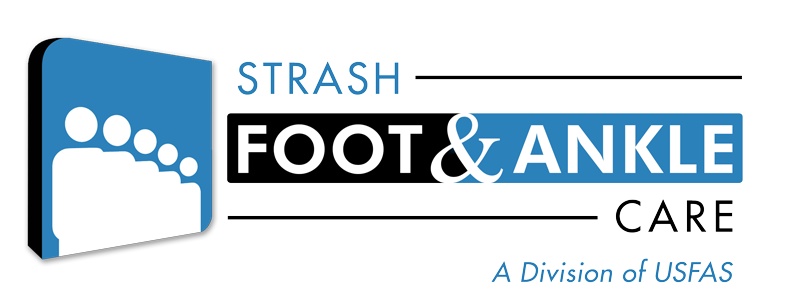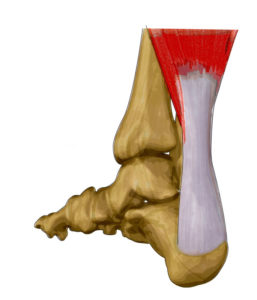19 Mar Achilles Tendonitis
The Achilles tendon is the largest tendon in the body and is found on the back of the ankle. Its primary function is to help you lift the back of your heel off the ground as you walk or run. The tendon connects the calf muscles to the back of the heel. Since we use the tendon with every step, it is subject to repetitive forces. If these forces are abnormal, a repetitive use injury can develop.
What is a repetitive use injury? It is a term used to describe an injury which is caused by performing motions over and over. A familiar example is carpal tunnel injury, which occurs from things such as typing and clicking your mouse. In the same way, many Achilles tendon injuries are caused by walking on your feet and having ABNORMAL forces placed on the tendon.
What are abnormal forces? One example would be a person who is overweight. Each step is placing forces on the Achilles tendon which are in excess of its capacity. As we abnormally stress the tendon with each step, cumulative damage and degeneration ensues. At first this damage will not necessarily be noticeable, but as time passes the damage accumulates, symptoms will develop. Another example is a person who starts an intense exercise program without properly conditioning the body to work at such stressful levels.
The Achilles tendon does not have a good blood supply or the ability to heal itself as effectively as other tendons in out body, so it is more prone to injury from repetitive stresses. Once the injury starts, the body is unable to effectively repair the damage and a chronic degeneration and scarring of the tissue occurs. If left untreated, the tendon will begin to degenerate and scar tissue will form. This is known as Achilles tendonosis. Achilles tendonosis can lead to complete rupture of the Achilles tendon.
There are two types of achilles tendonitis:
- Midsubstance Achilles tendonitis: The “middle” or midsubstance of the Achilles tendon has an inherent lack of good blood circulation which is common to everyone. When this area becomes damaged, it will often form a painful lump right in the middle of the tendon which can eventually tear or rupture.
- Insertional Achilles tendonitis: The area where the achilles tendon attaches to the heel bone can become inflamed and calcifications can form in this area. Often, these calcifications can grow and a hard painful bump will form on the back of your heel bone. The area is usually warm and painful to the touch.
The pain caused by Achilles tendonitis can develop gradually without a history of trauma. If left untreated, Achilles tendonitis can often lead to rupture. Symptoms include pain during exercise, swelling, redness, pain in the pack of the ankle when arising from rest, inability to walk without limping, or a cracking sensation. Squeezing the tendon from side to side can sometimes elicit significant pain.
Symptoms:
- Pain in the back of the ankle when walking or running. Pain is aggravated with increased activities.
- Squeezing of the tendon causes pain.
- Swelling and or warmth to the back of the heel.
- Achilles tendon has a lump or lumps in the back of the ankle.
- Pain is better when wearing shoes with a heel (high heels or boots) are used.
Diagnosis and Treatment
Radiographs, ultrasound and MRI along with a physical signs and symptoms are utilized to diagnose the condition.
Prior to initiation of podiatric treatment, it is important to determine the extent of damage to the Achilles tendon. Often times, patients can have mild symptoms and yet have significant degeneration of the tendon. This is why it is critical to seek medical care prior to attempting self treatment. If moderate to severe degeneration has taken place, complete rupture of the Achilles tendon can occur.
Non-surgical podiatric treatment of Achilles tendonitis is aimed at rest, stretching and improving range of motion. This is usually accomplished medication with icing, stretching, lifts, orthosis, physical therapy, cast immobilization, topical or oral anti-inflammatory medications and extra corporeal shockwave treatment. Early stage Achilles tendonitis can usually be treated successfully without surgery.
- Rest: Stopping or modifying whatever high impact activity you are doing can rest the tendon and eliminate abnormal forces. For example, if you are a runner, switching to biking or using an elliptical trainer can help.
- Immobilization: Often times, the extremity will need to be place in a CAM-boot or cast. If there is significant disease, the patient maybe placed in plantarflexed non-weight bearing below the knee cast.
- Stretching: Simple stretching exercises done DAILY can help decrease the abnormal forces on the tendon.
- Heel lift: Using a small heel lift in your shoe can put some “slack” in the tendon, giving it a change to rest.
- Icing: Apply ice to the area 10-15 minutes, two times per day.
- Extra corporeal shock wave therapy (ESWT): This podiatric technique breaks up the scar tissue that has formed in the tendon and helps increase circulation to the area facilitating the natural healing process.
If non-surgical treatment fails to provide adequate pain relief, surgery may be needed. Generally, podiatric surgery involves removal of the diseased portions of the tendon. Biological membranes maybe applied to augment the repair. Also, transfer of tendons from the foot to the ankle are sometimes needed when there is severe degeneration of the Achilles tendon. These surgeries typically are quite extensive and have a prolonged recovery. Fortunately, most cases of Achilles tendonitis do not require surgical management.
San Antonio, TX has a temperate climate. As a result outdoor sports and activities are popular throughout the year. Sports such as Golf, football and soccer are played year round. Consequently, as podiatrist, we see Achilles tendon injuries throughout the year with a slight up tick in spring and summer.


